Books by Divna Manolova
This is the first volume to explore the commentaries on ancient texts produced and circulating in... more This is the first volume to explore the commentaries on ancient texts produced and circulating in Byzantium. It adopts a broad chronological perspective (from the twelfth to the fifteenth century) and examines different types of commentaries on ancient poetry and prose within the context of the study and teaching of grammar, rhetoric, philosophy and science. By discussing the exegetical literature of the Byzantines as embedded in the socio-cultural context of the Komnenian and Palaiologan periods, the book analyses the frameworks and networks of knowledge transfer, patronage and identity building that motivated the Byzantine engagement with the ancient intellectual and literary tradition.
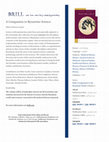
A Companion to Byzantine Science, Jan 13, 2020
This first book entirely devoted to Byzantine science is the result of the hugely diverse goals, ... more This first book entirely devoted to Byzantine science is the result of the hugely diverse goals, contexts, and accomplishments of the different scientific fields that developed through this civilisation’s eleven centuries of existence (4th-15th C.).
The introductory chapter focuses mainly on the modern vs Byzantine conceptions of science and to the semantic fields covered by this term, then and now, whereas the first two chapters analyse the Christianisation of pagan science and the beginnings of Byzantine science as well as its teaching during the Byzantine civilisation. Thereafter follow eleven chapters that cover the following fields: Logic, Arithmetic, Harmonic Theory, Geometry, Metrology, Optics and Mechanics, Theories of Vision, Meteorology and Physics, Astronomy, Geography, Zoology, Botany, Medicine and Pharmacology, Veterinary medicine, Science of warfare and Occult Sciences.
This volume, organized by topic, with essays by distinguished scholars offers the most comprehensive and up-to-date history of byzantine science currently available. It is an important editorial venture, aimed not only at specialists, including students of the history of Byzantine science, but the wider public, to all readers interested in medieval history in general.

by Foteini Spingou, Charles Barber, Nathan Leidholm, Thomas Carlson, Ivan Drpić, Alexandros (Alexander) Alexakis, elizabeth jeffreys, Theocharis Tsampouras, Mircea G . Duluș, Nikos Zagklas, Ida Toth, Alexander Riehle, Brad Hostetler, Michael Featherstone, Emmanuel C Bourbouhakis, Shannon Steiner, Efthymios Rizos, Divna Manolova, Robert Romanchuk, Maria Tomadaki, Kirsty Stewart, Baukje van den Berg, Katarzyna Warcaba, Florin Leonte, Vasileios Marinis, Ludovic Bender, Linda Safran, Sophia Kalopissi-Verti, Rachele Ricceri, Luisa Andriollo, Alex J Novikoff, Annemarie Carr, Marina Bazzani, Greti Dinkova-Bruun, Renaat Meesters, Daphne (Dafni) / Δάφνη Penna / Πέννα, Annemarie Carr, Alexander Alexakis, Jeremy Johns, Maria Parani, Lisa Mahoney, Irena Spadijer, and Ilias Taxidis ISBN: 9781108483056
Series: Sources for Byzantine Art History 3
In this book the beauty and m... more ISBN: 9781108483056
Series: Sources for Byzantine Art History 3
In this book the beauty and meaning of Byzantine art and its aesthetics are for the first time made accessible through the original sources. More than 150 medieval texts are translated from nine medieval languages into English, with commentaries from over seventy leading scholars. These include theories of art, discussions of patronage and understandings of iconography, practical recipes for artistic supplies, expressions of devotion, and descriptions of cities. The volume reveals the cultural plurality and the interconnectivity of medieval Europe and the Mediterranean from the late eleventh to the early fourteenth centuries. The first part uncovers salient aspects of Byzantine artistic production and its aesthetic reception, while the second puts a spotlight on particular ways of expressing admiration and of interpreting of the visual.
Publications by Divna Manolova
Oxford Bibliographies in Medieval Studies, 2024
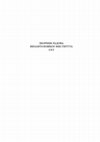
Zbornik radova Vizantoloskog instituta, 2023
The Historia Rhōmaïkē was written and circulated in Constantinople in several installments since ... more The Historia Rhōmaïkē was written and circulated in Constantinople in several installments since the 1340s. It recounts events in Byzantine history from the period from 1204 until ca. 1359. Today the work is preserved in more than forty manuscripts, two of which–Vatican City, Biblioteca Apostolica Vaticana, codd. Vat. gr. 165 and 164–were partially copied, annotated, and revised by Gregoras himself. The pinakes, marginal, and chapter titles in both codices indicate that the latter were designed as an edition of the first seventeen books of the History. The present paper studies Gregoras’ historiographical project and a selection of his letters and hagiographical works in order to explore Gregoras’ self referential remarks on ‘novelty’ and ‘innovation’, as well as his reflections on the aesthetic value of variety and the pleasure the latter can incite. It also adduces as evidence some of the ‘editorial’ decisions the two Vatican manuscripts preserving the Roman History display, such as the chapter division and its relationship to the pinax of each volume, and the role of marginal titles in guiding the readers’ emotional response or alternatively, in directing how the text should be performed. Gregoras’ remarks on novelty and its relation to diversity and perception indicate his concern with the reception of his literary production, which in turn, reaffirms the importance of rhetoric in Palaiologan Byzantium.
Sources for Byzantine Art History, vol. 3: The Visual Culture of Later Byzantium (1081-c. 1350), 2022
Translation co-authored with Paul Magdalino. In Sources for Byzantine Art History, vol. 3: The Vi... more Translation co-authored with Paul Magdalino. In Sources for Byzantine Art History, vol. 3: The Visual Culture of Later Byzantium (1081-c. 1350), edited by Foteini Spingou, 630–42. Cambridge: Cambridge University Press, 2022.
The Diagram as Paradigm: Cross-Cultural Approaches, 2022
Edited by Jeffrey F. Hamburger, David Roxburgh, Linda Safran. Dumbarton Oaks Byzantine Symposia a... more Edited by Jeffrey F. Hamburger, David Roxburgh, Linda Safran. Dumbarton Oaks Byzantine Symposia and Colloquia series. Washington, DC: Dumbarton Oaks Research Library and Collection, 2022.
ISBN 9780884024866
Emotions through Time: From Antiquity to Byzantium, 2022
Edited by Douglas Cairns, Martin Hinterberger, Aglae Pizzone, and Matteo Zaccarini. Emotions in A... more Edited by Douglas Cairns, Martin Hinterberger, Aglae Pizzone, and Matteo Zaccarini. Emotions in Antiquity. Mohr Siebeck, 2022.

Byzantine Commentaries on Ancient Greek Texts, 12th-15th Centuries, 2022
This introduction sets forth the approach to Byzantine commentaries on ancient Greek texts taken ... more This introduction sets forth the approach to Byzantine commentaries on ancient Greek texts taken in this volume: it places the Komnenian and Palaiologan commentaries firmly within their intellectual and socio-cultural contexts and examines the process of commenting on ancient texts as a deliberate and culturally significant choice made by the commentators. We define commentary both in a narrow and a broad sense. In the narrowest sense, commentaries are concerned with explaining an ancient text and the knowledge related to it, often in a didactic context. Defined more broadly, commentaries include treatises on ancient literature and paraphrases of ancient authorities, which likewise demonstrate how these texts were read and taught. In the broadest sense, commentaries can be any literary texts that creatively engage with ancient texts and thus shed light on Byzantine attitudes towards their ancient heritage. The very practice of composing commentaries on ancient texts was a creative and targeted enterprise of identity building. The introduction discusses different kinds of Byzantine commentaries on ancient poetry and prose within the context of the study and teaching of grammar, rhetoric, philosophy and science, and introduces some of the key figures of the Komnenian and Palaiologan periods.

Interfaces: A Journal of Medieval European Literatures, 2021
This article is available open access through the 'Interfaces' website. The link is provided. Alt... more This article is available open access through the 'Interfaces' website. The link is provided. Alternatively, you can find it through its DOI number.
This article is about the interplay between diagrammatic representation, the mediation of mirrors, and visual cognition. It centres on Demetrios Triklinios (fl. ca. 1308–25/30) and his treatise on lunar theory. The latter includes, first, a discussion of the lunar phases and of the Moon's position in relation to the Sun, and second, a narrative and a pictorial description of the lunar surface. Demetrios Triklinios's Selenography is little-known (though edited in 1967 by Wasserstein) and not available in translation into a modern scholarly language. Therefore, one of the main goals of the present article is to introduce its context and contents and to lay down the foundations for their detailed study at a later stage. When discussing the Selenography, I refer to a bricolage consisting of the two earliest versions of the work preserved in Bayerische Staatsbibliothek, graecus 482, ff. 92r–95v (third quarter of the fourteenth century) and Paris, Bibliothèque nationale de France, graecus 2381, ff. 78r–79v (last quarter of the fourteenth century). I survey the available evidence concerning the role of Demetrios Triklinios (the author), John Astrapas (?) (the grapheus or scribe-painter), and Neophytos Prodromenos and Anonymus (the scribes-editors) in the production of the two manuscript copies. Next, I discuss the diagrams included in the Selenography and their functioning in relation to Triklinios's theory concerning the Moon as a mirror reflecting the geography of the Earth, on the one hand, and to the mirror experiment described by Triklinios, on the other. Finally, I demonstrate how, even though the Selenography is a work on lunar astronomy, it can also be read as a discussion focusing on the Mediterranean world and aiming at elevating its centrality and importance on a cosmic scale.
Table of contents
1. Introduction: Questions of (dis)continuity and the ‘why not’ question
2. The... more Table of contents
1. Introduction: Questions of (dis)continuity and the ‘why not’ question
2. The cursus studiorum
3. The educational context
4. Scientific books: The path of learning
5. Fragmenting knowledge
6. Outlining knowledge
7. Other pedagogical strategies
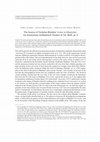
Jahrbuch der Österreichischen Byzantinistik, 2018
EVWUDFW 7KH DUWLFOH SUHVHQWV WKH HGLWLRQ DQG D GHWDLOHG GLVFXVVLRQ RI DQ DQRQ\PRXV WUHDWLVH RI HO... more EVWUDFW 7KH DUWLFOH SUHVHQWV WKH HGLWLRQ DQG D GHWDLOHG GLVFXVVLRQ RI DQ DQRQ\PRXV WUHDWLVH RI HOHPHQWDU\ DULWKPHWLF WKDW VHUYHG DV WKH VRXUFH RI WKH VRFDOOHG Letter to Khatzykes DXWKRUHG E\ WKH %\]DQWLQH VFKRODU 1LFKRODV $UWDEDVGRV 5KDEGDV $Q XSGDWHG VXUYH\ RI WKH H[WDQW HYLGHQFH DERXW WKH ORJLVWLF WUHDWLVHV FRPSRVHG LQ WKH 1LFDHDQ SHULRG DQG LQ WKH HDUO\ 3DODLRORJDQ HUD DQG D GLVFXVVLRQ RI WKH prima facie VXUSULVLQJO\ ZLGHVSUHDG SKHQRPHQRQ RI DSSURSULDWLRQ RI VFLHQWLILF WUHDWLVHV ZULWWHQ E\ RWKHU FRQ WHPSRUDULHV LQ ODWH %\]DQWLQH WLPHV ZLOO DOVR EH SURYLGHG +LV SURGXFWLRQ KRZHYHU ZDV DVVHVVHG LQ D ZD\ WKDW LV SDUDGLJPDWLF RI D JHQHUDOL]HG GLVPLVVLYH DWWLWXGH WR %\]DQWLQH VFLHQFH 3 7ൺඇඇൾඋඒ 0DQXHO 0RVFKRSRXORV HW 1LFRODV 5KDEGDV Bulletin des Sciences mathématiques e VpULH ± UHSU ,ൽ 0pPRLUHV 6FLHQWLILTXHV ,9 7RXORXVH±3DULV ± LQ IDFW SDVVHG WKH IROORZLQJ MXGJPHQW RQ 5KDEGDV ¶ ZULWLQJV ZKRVH HGLWLRQ KH QHYHUWKHOHVV SXEOLVKHG WZR \HDUV ODWHU ³/ ¶LQWpUrW GH VHV pFULWV HVW VXUWRXW GH PRQWUHU MXVTX ¶R pWDLHQW WRPEpV OHV KpULWLHUV GpJpQpUpV GX QRP KHOOqQH FHX[Oj PrPH TXL DYDLHQW DORUV 'LRSKDQWH HQWUH OHXUV PDLQV´ $FFRUGLQJ WR WKH WKFHQWXU\ 1HRSODWRQLF FRPPHQWDWRU (XWRFLXV GLYLGLQJ WKH XQLW GRHV QRW SHUWDLQ WR DULWKPHWLF EXW WR ORJLV WLF -/ +ൾංൻൾඋ HG $UFKLPHGLV RSHUD RPQLD FXP FRPPHQWDULLV (XWRFLL ,±,,, /LSVLDH ± ,,, ± ੮ıIJ ¶ ਥʌ ¶ ਥțİȓȞȦȞ >scil VXSHUSDUWLFXODU DQG VXSHUSDUWLHQW UDWLRV@ įȚĮȚȡİIJȑȠȞ IJȞ ȝȠȞȐįĮ İੁ țĮ ȝ țĮIJ IJઁ ʌȡȠıોțȠȞ IJૌ ਕȡȚșȝȘIJȚțૌ ਕȜȜ IJૌ ȜȠȖȚıIJȚțૌ IJȣȖȤȐȞİȚ ³VR WKDW IRU WKHP RQH KDV WR GLYLGH WKH XQLW HYHQ LI WKLV GRHV QRW KDSSHQ WR ILW WR DULWKPHWLF EXW WR ORJLVWLF´ $Q HDUOLHU GHILQLWLRQ RI ORJLVWLF²ZKLFK FDQ DOPRVW FHUWDLQO\ EH DVFULEHG WR *HPLQXV D VWFHQWXU\ %&( PDWKHPDWLFDOO\PLQGHG SKLORVRSKHU PD\EH D SXSLO RI 3RVLGRQLXV²GRHV QRW DOORZ GLYLGLQJ WKH XQLW 7KLV GHILQLWLRQ FDQ EH IRXQG LQ SVHXGR+HUR Def ± -/ +ൾංൻൾඋ ± / 1ංඑ ± : 6ർආංൽඍ ± + 6ർදඇൾ HGV +HURQLV $OH[DQGULQL RSHUD TXDH VXSHUVXQW RPQLD ,±9 /LSVLDH ± ,9 ± DQG LV DOVR SUHVHUYHG WKURXJK D GLIIHUHQW OLQH RI WUDGLWLRQ DV D VFKROLXP WR 3ODWR Chrm ൾ 6FKROLXP LQ ' &ඎൿൺඅඈ 6FKROLD *UDHFD LQ 3ODWRQHP , 6FKROLD DG GLD ORJRV WHWUDORJLDUXP ,±9,, FRQWLQHQV >Pleiadi @ 5RPD ,W LV SRVVLEOH WKDW WKH GRPDLQ RI ORJLVWLF ZDV H[SDQGHG WR LQFOXGH IUDFWLRQDO SDUWV DV D FRQVHTXHQFH RI WKH DGRSWLRQ RI WKH VH[DJHVLPDO V\VWHP LQ *UHHN PDWKHPDWLFDO DVWURQRP\ ,Q IDFW ORJLVWLF GHYHORSHG JUHDWO\ LQ /DWH $QWLTXLW\ DV D VXSSRUW WR PDWKHPDWLFDO DVWURQRP\ DQG DOVR SOD\HG WKLV VDPH UROH LQ WKH %\]DQWLQH SHULRG 7KH ILUVW NQRZQ WUHDWLVH RI WKLV NLQG LV LQFOXGHG LQ WKH Prolegomena to the Almagest DQG DPRXQWV WR WKH QRQUHGDFWHG OHFWXUH QRWHV RI D FRXUVH KHOG LQ WKH FLUFOH RI WKH 1HRSODWRQLF SKLORVRSKHU $PPRQLRV 7KLV WUHDWLVH LV D FRPSXWDWLRQDO SULPHU WR WKH Almagest D WLJKWO\ RUJDQL]HG ³KDQGERRN RI ORJLVWLF´ IHDWXULQJ DV LWV PDLQ WKHPHV DQ LQWURGXF WLRQ WR WKH VH[DJHVLPDO V\VWHP D GHVFULSWLRQ RI FRPSXWDWLRQDO DOJRULWKPV IRU PXOWLSOLFDWLRQ GLYLVLRQ DQG H[WUDFWLRQ RI DQ DSSUR[LPDWH VTXDUH URRW D SUHVHQWDWLRQ RI LQWHUSRODWLRQ WHFKQLTXHV DQG DQ H[SRVLWLRQ DERXW FRPSRXQGHG UDWLRV DQG UHPRYDO RI D UDWLR IURP D UDWLR $FFRUGLQJ WR WKH DQRQ\PRXV DXWKRU QR FRPSUHKHQVLYH SUHYLRXV H[SRVLWLRQ RI WKLV NLQG H[LVWHG² DQG LQ IDFW QR VXFK RQH KDV EHHQ WUDQVPLWWHG WR XV 6HH DOVR QRWH EHORZ 7KH EHVW LQWURGXFWLRQ WR *UHHN ORJLVWLF LV VWLOO . 9ඈൾඅ %HLWUlJH ]XU JULHFKLVFKHQ /RJLVWLN (UVWHU 7HLO Sitzungsberichte der Bayerischen Akademie der Wissenschaften, Mathematisch-naturwissenschaftliche Abteilung 0XQLFK ± &I WKH H[SOLFLW VWDWHPHQW RSHQLQJ Anonymus $ $අඅൺඋൽ /H SUHPLHU WUDLWp E\]DQWLQ GH FDOFXO LQGLHQ FODVVHPHQW GHV PDQXVFULWV HW pGLWLRQ FULWLTXH GX WH[WH Revue d'Histoire des Textes ± ± DQG LQ D VPRRWKHU IRUPXODWLRQ 3ODQXGHV ¶ Great Calculation $ $අඅൺඋൽ HG 0D[LPH 3ODQXGH /H JUDQG FDOFXO VHORQ OHV ,QGLHQV /RXYDLQOD1HXYH ± 'HVSLWH LWV WLWOH DQG WKH DXWKRU ¶V VWDWHPHQW VLPLODU WR WKDW RI 3ODQXGHV 3 &ൺඋൾඅඈඌ >HG@ ǺĮȡȜĮȝ IJȠ૨ ȀĮȜĮȕȡȠ૨ ȁȠȖȚıIJȚț %DUODDP YRQ 6HPLQDUD /RJLVWLNp >Corpus philosophorum Medii AEvi. Philosophi byzantini @ $WKHQV±3DULV± %UXVVHOV ± %DUODDP ¶ Logistic LV QRW D ZULWLQJ RI ORJLVWLF EXW D IXOO\IOHGJHG WUHDWLVH RI WKHRUHWLFDO DULWKPHWLF IRUPXODWHG LQ DQ LPSHFFDEOH GHPRQVWUDWLYH VW\OH %DUODDP PLP QR XQGLVSXWDEO\ WKH %\]DQWLQH VFKRODU EHVW YHUVHG LQ PDWKHPDWLFDO PDWWHUV DQG D PDMRU DFWRU LQ WKH KHV\FKDVWLF FRQWURYHUV\ GLHG LQ 6HH PLP QR 7KH XQSXEOLVKHG JUDPPDWLFDO V\QRSVLV DGGUHVVHG WR 3DXO LV SUHVHUYHG LQ WKH PLVFHOODQHRXV PV 3DULV %LEOLRWKqTXH QDWLRQDOH GH )UDQFH JU Diktyon II U±Y 7KH FRS\LQJ LV GDWHG 'HFHPEHU DP > @ I Y FHUWDLQO\ UHIHUULQJ WR II U±Y DQG SRVVLEO\ DOVR WR II U±Y DQG Y±Y SHQQHG E\ WKH VDPH KDQG +RZHYHU WKH VFULSW RI 5KDEGDV ¶ V\QRSVLV ORFDWHG LQ TXLUH QR Țș D WHUQLRQ FORVHG E\ WKH EODQN II U±U VHHPV HDUOLHU SHUKDSV GDWLQJ EDFN WR WKH PLGGOH ± WKLUG TXDUWHU RI WKH WK FHQWXU\ 7KH V\QRSVLV LV SUHVHQWHG DV D JUDPPDWLFDO FRP SHQGLXP ZKRVH DLP LV H[SRXQGLQJ WKH DSSURSULDWH XVH RI ZRUGV LQ RUGHU WR DYRLG EDUEDULVPV DQG VROHFLVPV 7KH H[SRVLWLRQ LV EDVHG RQ DQDO\WLFDO GLYLVLRQV RI WKH PDLQ JUDPPDWLFDO LVVXHV WUHDWHG E\ PHDQV RI ȝȚțȡȠȪȢ IJȚȞĮȢ ਫ਼ʌȠȝȞȘȝĮIJȚıȝȠȪȢ ³VRPH VKRUW QRWHV´ ,W VWDUWV IURP OHWWHUV ȖȡȐȝȝĮIJĮ DQG ıIJȠȚȤİĮ DQG JRHV RQ GHDOLQJ ZLWK V\OODEOHV DQG ZRUGV LQVRIDU DV WKH\ DUH

A Companion to Byzantine Epistolography, 2020
The present contribution argues that the study of the interaction between philosophy and epistolo... more The present contribution argues that the study of the interaction between philosophy and epistolography in Byzantium faces a number of methodological challenges. First, the study of Byzantine philosophical literature, including philosophical epistolography, depends on one’s definition of philosophy in respect to its cultural, intellectual, social, and disciplinary context in Byzantium. Second, essential for the examination of philosophical epistolography in Byzantium is the critical assessment of the category of philosophical letter and its relevance to the Byzantine material. Finally, the author argues that one possible venue for examining philosophical epistolography in Byzantium is the discussion of literary friendship and theories of friendship as developed in friendship letters. To illustrate the theoretical approach it proposes, this contribution offers a case study of two letters written by Nikephoros Gregoras (d. c.1360).
Sine arte scientia nihil est: Изследвания в чест на проф. дфн Олег Георгиев, 2019
The chapter is available open access, in Bulgarian, through Zenodo (https://zenodo.org/record/429... more The chapter is available open access, in Bulgarian, through Zenodo (https://zenodo.org/record/4298472#.YxW6uy0RqS4).
[Manuel Holobolos, Maximos Planudes, and Boethius: Translating παιδεία in Late Byzantium] In Sine arte scientia nihil est: Изследвания в чест на проф. дфн Олег Георгиев [Sine arte scientia nihil est: Festschrift for Prof. Oleg Georgiev], edited by Georgi Kapriev, 277–91. Sofia: St. Kliment Ohridski University Press, 2019.
Toward a Historical Sociolinguistic Poetics of Medieval Greek, edited by Andrea M. Cuomo and Erich Trapp. Byzantioς, Studies in Byzantine History and Civilization 12. Turnhout: Brepols Publishers, 2017
Licence: CC BY–NC 4.0; Gold Open Access publication
New Europe College Yearbook 2014–2015, 2018
The present article inquires into the philosophical conceptions of spontaneity and chance, fate a... more The present article inquires into the philosophical conceptions of spontaneity and chance, fate and necessity, free will and divine providence employed by Nikephoros Gregoras (d. ca. 1360) in his historiographical project Historia Rhōmaïkē. Based on examples from Gregoras' letters, First Antirrhetics and his History, the author argues that Gregoras drew on Aristotle and Ptolemy for his views on chance and spontaneity, whereas with respect to historical agency and causality, he emphasized the role of the free individual will which he understood as independent from necessity and fate and reconciled with divine foreknowledge.
Dialogues and Debates from Late Antiquity to Late Byzantium, 2017
Medieval Letters. Between Fiction and Document, 2015
MediterraneoS: An Interdisciplinary Approach to the Cultures of the Mediterranean Sea, 2013


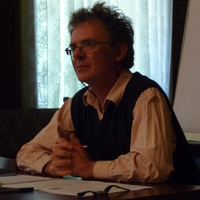






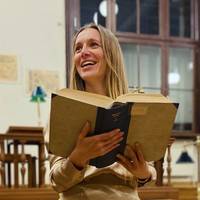

Uploads
Books by Divna Manolova
The introductory chapter focuses mainly on the modern vs Byzantine conceptions of science and to the semantic fields covered by this term, then and now, whereas the first two chapters analyse the Christianisation of pagan science and the beginnings of Byzantine science as well as its teaching during the Byzantine civilisation. Thereafter follow eleven chapters that cover the following fields: Logic, Arithmetic, Harmonic Theory, Geometry, Metrology, Optics and Mechanics, Theories of Vision, Meteorology and Physics, Astronomy, Geography, Zoology, Botany, Medicine and Pharmacology, Veterinary medicine, Science of warfare and Occult Sciences.
This volume, organized by topic, with essays by distinguished scholars offers the most comprehensive and up-to-date history of byzantine science currently available. It is an important editorial venture, aimed not only at specialists, including students of the history of Byzantine science, but the wider public, to all readers interested in medieval history in general.
Series: Sources for Byzantine Art History 3
In this book the beauty and meaning of Byzantine art and its aesthetics are for the first time made accessible through the original sources. More than 150 medieval texts are translated from nine medieval languages into English, with commentaries from over seventy leading scholars. These include theories of art, discussions of patronage and understandings of iconography, practical recipes for artistic supplies, expressions of devotion, and descriptions of cities. The volume reveals the cultural plurality and the interconnectivity of medieval Europe and the Mediterranean from the late eleventh to the early fourteenth centuries. The first part uncovers salient aspects of Byzantine artistic production and its aesthetic reception, while the second puts a spotlight on particular ways of expressing admiration and of interpreting of the visual.
Publications by Divna Manolova
ISBN 9780884024866
This article is about the interplay between diagrammatic representation, the mediation of mirrors, and visual cognition. It centres on Demetrios Triklinios (fl. ca. 1308–25/30) and his treatise on lunar theory. The latter includes, first, a discussion of the lunar phases and of the Moon's position in relation to the Sun, and second, a narrative and a pictorial description of the lunar surface. Demetrios Triklinios's Selenography is little-known (though edited in 1967 by Wasserstein) and not available in translation into a modern scholarly language. Therefore, one of the main goals of the present article is to introduce its context and contents and to lay down the foundations for their detailed study at a later stage. When discussing the Selenography, I refer to a bricolage consisting of the two earliest versions of the work preserved in Bayerische Staatsbibliothek, graecus 482, ff. 92r–95v (third quarter of the fourteenth century) and Paris, Bibliothèque nationale de France, graecus 2381, ff. 78r–79v (last quarter of the fourteenth century). I survey the available evidence concerning the role of Demetrios Triklinios (the author), John Astrapas (?) (the grapheus or scribe-painter), and Neophytos Prodromenos and Anonymus (the scribes-editors) in the production of the two manuscript copies. Next, I discuss the diagrams included in the Selenography and their functioning in relation to Triklinios's theory concerning the Moon as a mirror reflecting the geography of the Earth, on the one hand, and to the mirror experiment described by Triklinios, on the other. Finally, I demonstrate how, even though the Selenography is a work on lunar astronomy, it can also be read as a discussion focusing on the Mediterranean world and aiming at elevating its centrality and importance on a cosmic scale.
1. Introduction: Questions of (dis)continuity and the ‘why not’ question
2. The cursus studiorum
3. The educational context
4. Scientific books: The path of learning
5. Fragmenting knowledge
6. Outlining knowledge
7. Other pedagogical strategies
[Manuel Holobolos, Maximos Planudes, and Boethius: Translating παιδεία in Late Byzantium] In Sine arte scientia nihil est: Изследвания в чест на проф. дфн Олег Георгиев [Sine arte scientia nihil est: Festschrift for Prof. Oleg Georgiev], edited by Georgi Kapriev, 277–91. Sofia: St. Kliment Ohridski University Press, 2019.
The introductory chapter focuses mainly on the modern vs Byzantine conceptions of science and to the semantic fields covered by this term, then and now, whereas the first two chapters analyse the Christianisation of pagan science and the beginnings of Byzantine science as well as its teaching during the Byzantine civilisation. Thereafter follow eleven chapters that cover the following fields: Logic, Arithmetic, Harmonic Theory, Geometry, Metrology, Optics and Mechanics, Theories of Vision, Meteorology and Physics, Astronomy, Geography, Zoology, Botany, Medicine and Pharmacology, Veterinary medicine, Science of warfare and Occult Sciences.
This volume, organized by topic, with essays by distinguished scholars offers the most comprehensive and up-to-date history of byzantine science currently available. It is an important editorial venture, aimed not only at specialists, including students of the history of Byzantine science, but the wider public, to all readers interested in medieval history in general.
Series: Sources for Byzantine Art History 3
In this book the beauty and meaning of Byzantine art and its aesthetics are for the first time made accessible through the original sources. More than 150 medieval texts are translated from nine medieval languages into English, with commentaries from over seventy leading scholars. These include theories of art, discussions of patronage and understandings of iconography, practical recipes for artistic supplies, expressions of devotion, and descriptions of cities. The volume reveals the cultural plurality and the interconnectivity of medieval Europe and the Mediterranean from the late eleventh to the early fourteenth centuries. The first part uncovers salient aspects of Byzantine artistic production and its aesthetic reception, while the second puts a spotlight on particular ways of expressing admiration and of interpreting of the visual.
ISBN 9780884024866
This article is about the interplay between diagrammatic representation, the mediation of mirrors, and visual cognition. It centres on Demetrios Triklinios (fl. ca. 1308–25/30) and his treatise on lunar theory. The latter includes, first, a discussion of the lunar phases and of the Moon's position in relation to the Sun, and second, a narrative and a pictorial description of the lunar surface. Demetrios Triklinios's Selenography is little-known (though edited in 1967 by Wasserstein) and not available in translation into a modern scholarly language. Therefore, one of the main goals of the present article is to introduce its context and contents and to lay down the foundations for their detailed study at a later stage. When discussing the Selenography, I refer to a bricolage consisting of the two earliest versions of the work preserved in Bayerische Staatsbibliothek, graecus 482, ff. 92r–95v (third quarter of the fourteenth century) and Paris, Bibliothèque nationale de France, graecus 2381, ff. 78r–79v (last quarter of the fourteenth century). I survey the available evidence concerning the role of Demetrios Triklinios (the author), John Astrapas (?) (the grapheus or scribe-painter), and Neophytos Prodromenos and Anonymus (the scribes-editors) in the production of the two manuscript copies. Next, I discuss the diagrams included in the Selenography and their functioning in relation to Triklinios's theory concerning the Moon as a mirror reflecting the geography of the Earth, on the one hand, and to the mirror experiment described by Triklinios, on the other. Finally, I demonstrate how, even though the Selenography is a work on lunar astronomy, it can also be read as a discussion focusing on the Mediterranean world and aiming at elevating its centrality and importance on a cosmic scale.
1. Introduction: Questions of (dis)continuity and the ‘why not’ question
2. The cursus studiorum
3. The educational context
4. Scientific books: The path of learning
5. Fragmenting knowledge
6. Outlining knowledge
7. Other pedagogical strategies
[Manuel Holobolos, Maximos Planudes, and Boethius: Translating παιδεία in Late Byzantium] In Sine arte scientia nihil est: Изследвания в чест на проф. дфн Олег Георгиев [Sine arte scientia nihil est: Festschrift for Prof. Oleg Georgiev], edited by Georgi Kapriev, 277–91. Sofia: St. Kliment Ohridski University Press, 2019.
The lecture will serve as an introduction to the main cosmological ideas in Byzantium and will offer a survey of the available manuscript evidence. Beyond that, however, and in dialogue with the Liber Floridus, it will unpack and examine how scientific illustrations, especially the diagrammatic ones, function as abstractions and representations of what is otherwise unseen but imaginable, as for instance the tiniest particles in nature or the entirety of the creation.
https://www.youtube.com/watch?v=iJMwvmYmbs4
This is a talk about cosmological diagrams and the ways in which they make the universe — its construction, articulation and movement — meaningful to us. In this sense, this is also a talk about imagination and specifically, about the type of imagination required to depict the world. I shall focus on spherical models of the universe and discuss them in the context of fourteenth-century Byzantium. The case study I will examine in most detail is that of Munich, Bayerische Staatsbibliothek, Graecus 482, which transmits Cleomedes’ The Heavens – a Stoic introduction to cosmology and elementary astronomy.
The Heavens is also the main source for one of the most celebrated achievements in the history of Greek mathematics, namely Eratosthenes’ calculation of the circumference of the Earth. The account of Eratosthenes’ procedure is usually accompanied by diagrams and f. 31r of the codex Monacensis includes one its most illustrative and most puzzling representations. In order to familiarise themselves with Eratosthenes’ method of calculation, attendees might find useful watching Carl Sagan’s short explanation included in the very first episode of Cosmos: A Personal Voyage (aired on 28 September 1980; https://bit.ly/2gCHNbU).
This communication discusses a sample of wind diagrams preserved in Palaiologan manuscripts, usually, though not exclusively, in connection to copies of Aristotle’s Meteorologica and related commentaries. After a brief survey of the most frequent diagrammatic patterns of representing the winds and of several notable exceptions, my analysis discusses the ways, in which wind diagrams 1) structure both the sublunar (terrestrial) and the supralunar (celestial) space by dividing it into segments and by indicating the cardinal directions; 2) articulate the relationships, interaction and interdependencies between the celestial and terrestrial phenomena within a given cosmological framework; 3) relate to alternative discursive modes used to preserve and structure the knowledge about the nature of the winds, such as textual discussions and lists.
The video is filmed, edited, and produced by Divna Manolova.
The video is available here: https://www.youtube.com/watch?v=pE1XUgxBqxk&t=13s
https://www.youtube.com/watch?v=pGGs73nl51k&t=19s
https://www.doaks.org/research/byzantine/podcast/episode-2-renaissance-self-fashioning
An interactive game based on medieval diagrams for the Humanities Research Centre’s 10th anniversary.
At the end of May, York-based CML-ers temporarily migrated from University of York to Syddansk Universitet in Odense. Our journey took us to Copenhagen where Davids Samling and Black Diamond Royal Library hosted us for the Shared Moveable Worlds workshop (http://cml.sdu.dk/event/cml-workshop-shared-worlds). Having returned to York and just before IMC Leeds and the summer (hopefully!), we'd like to share with all of you a "moving images" expression of our trip.
In its pilot 2022 edition, HSMW Summer School introduced the participants to the medieval epistemic fields (sciences) which study the natural world (the kosmos) as a space, namely geography, cosmography, and astronomy. In 2024, we shift the focus to the history of knowledge and the practitioners and their practices: from the geographers and the astronomers, the map and instrument makers, to the users of medieval herbals and the artisans preparing sgraffito pottery and enamel.
The instructors include: Marie-Hélène Blanchet (CNRS, UMR 8167 Orient et Méditerranée, Monde byzantin); Chiara D’Agostini (Department of Culture and Language, University of Southern Denmark); Aneta Dimitrova (Faculty of Slavic Studies, Sofia University “St. Kliment Ohridski”); Stephanie Drew (Centre for Medieval Studies, University of York); Rossina Kostova (Department of Archaeology, Faculty of History, St Cyril and St Methodius University of Veliko Tarnovo); Divna Manolova (MSCA Paris Region Postdoctoral Fellow, Université PSL-Observatoire de Paris, SYRTE, CNRS); Angel Nikolov (Faculty of History, Sofia University “St. Kliment Ohridski”); Shannon Steiner (Independent Researcher, Practicing Goldsmith).
Join us in Veliko Tarnovo, this summer, between 18–22 July 2022 for the Pilot Edition of the HISTORY OF SCIENCE IN THE MEDIEVAL WORLD SUMMER SCHOOL
Deadline for submitting an application: 29 April 2022.
There is no registration fee.
Full schedule: https://www.uni-vt.bg/res/14892/SSHistMedSci_Final_Program.pdf
Please address your informal inquiries and your application materials to Dr Divna Manolova at dvmanolova@mpiwg-berlin.mpg.de.
Summer School Philosophy and Vision
The School studies the wider medieval world of Afro-Eurasia and aims to shed light on Byzantium and the Slavonic world, and their intellectual heritage as agents in the development of medieval science, which, though significant, nevertheless remain largely unknown to the scholarly community. Even though current scholarship is focused on the so-called ‘Global Medieval’, the medieval Slavonic, Byzantine and Black Sea regions remain a blind spot for both the researchers and the general public outside of Central, Eastern and Southeastern Europe. Thus, the School aims at positioning Byzantium and the Slavonic world on the map of history of medieval science, thus offering the participants the rare opportunity to get acquainted with their respective heritage.
In its pilot edition, the Summer School will problematize the medieval manuscript and approach it as a space and as a territory. Building upon this conceptual premise, the School will also introduce students to the medieval epistemic fields (sciences) which study the natural world (the kosmos) as a space, namely geography, cosmography and astronomy. Students will acquire fundamental knowledge concerning the place and role of the sciences in the intellectual world of the Middle Ages. They will also develop an understanding of premodern science as a spectrum of disciplines wider than the late antique framework of the four mathematical sciences (arithmetic, music, geometry, and astronomy) and inclusive of all epistemic domains dedicated to the intellectual exploration of the natural world (the kosmos) and of humanity. The School relies on a discussion-based and experiential / experimental format. That is, the School includes workshops, which will guide the students into the use of medieval instruments and maps as preserved in the surviving manuscripts.
The common discussion language of the School will be English.
If the participants know a medieval scholarly language (for this pilot edition: Latin, Greek and/or Old Church Slavonic, but in the future also Persian, Arabic, Chinese, Classical Armenian, and so forth), this would be an advantage, but it is not an essential requirement for participation.
During the selection process, preference will be given to MA and PhD students, but researchers with interest in the Middle Ages and / or History of Science can also apply.
Available places: The School offers twelve places for in-person participants wishing to attend both the morning (lectures) and afternoon (workshops) sessions.
There is no limit for the number of online participants, but their registration is restricted solely to the morning sessions.
We cannot offer any financial support to cover travel and accommodation expenses.
There is no registration fee.
In order to apply, please send a short bio and description of what motivates your application (maximum one page altogether). Please indicate in your application whether you would like to attend the Summer School in person or online.
The participants work across diverse fields of medieval literature, including French, Arabic, English, Latin, Hebrew, Greek, Slavic, Irish, and Spanish literatures.
Organizers: Divna Manolova, Elizabeth Tyler, Julian Yolles, and Rosa M. Rodríguez Porto
A blog post about the event is published and available here: https://cml.sdu.dk/blog/constructive-absences-in-medieval-literature-a-transformations-translocations-workshop
This workshop aims to explore the ways in which the Byzantines used—preserved, commented, adapted—ancient literature. We therefore invite abstracts that explore commentaries on ancient texts throughout the Byzantine period. We define ‘commentary’ in a broad sense, to include generically diverse texts that in one way or another comment on the ancient literary heritage. Questions that might be addressed include but are not limited to the following: What (contemporary) questions of meaning do Byzantine commentators seek to answer? What is their hermeneutic and/or didactic programme? How do commentators perceive their own role in preserving or defending the authority of the ancient text? What function do these commentaries fulfil within their intellectual and socio-cultural context? What is the relationship between commentaries on ancient texts and the transtextual use of ancient texts in Byzantine literary practice?
The original English version was published online in 2020: https://istanbultarihi.ist/678-measuring-the-world-science-and-technology-in-byzantine-constantinople